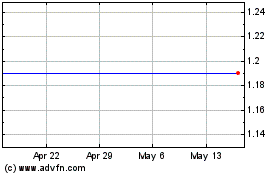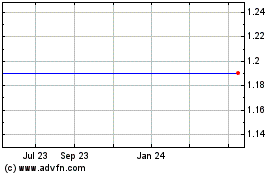Third-Party Study of webMethods' Customers Highlights Emerging Best Practices and Measurable Business Benefits for Service-Orien
November 15 2005 - 8:30AM
PR Newswire (US)
Among Many Benefits, Nucleus Research Finds that Expanded Reuse of
Existing Services Reduces Project Cycle Time 25-45 Percent While
Directly Supporting Key Business Objectives ATLANTA, Nov. 15
/PRNewswire/ -- Integration World 2005 -- webMethods, Inc.
(NASDAQ:WEBM), a leading business integration and optimization
software company, today announced that a recently published,
third-party report highlights the emerging best practices that
enterprises are using to employ a service-oriented architecture
(SOA) with webMethods Fabric(TM). According to the report, these
enterprises are greatly enhancing their IT responsiveness and
agility while realizing significant business benefits as a result.
The analysis, ROI Evaluation Report: webMethods Fabric (November
2005), was produced by Nucleus Research, a global provider of IT
research and advisory services, following interviews with a number
of webMethods' customers. "Adopting a service-oriented architecture
(SOA) enables companies to shorten IT project cycles, improve IT
agility and better align their IT practices with overall company
strategy while gaining tactical returns from integration," said
Rebecca Wettemann, vice president, research, Nucleus Research.
"Nucleus found customers adopting webMethods Fabric to support an
SOA strategy were able to leverage IT alignment and agility to
increase market share, build strategic partnerships, increase
revenues and improve customer service." One of the principal
business benefits reported by webMethods' users was the role that a
service-oriented architecture played in growing top-line revenue as
enterprises were able to improve the overall agility of their IT
departments as well as their long-term alignment with
line-of-business objectives. Among the examples cited, the report
found that a retirement fund administrator was able to win
significant business and achieve a number one market share position
by successfully employing an SOA to streamline new customer
acquisitions. Likewise, a technology distributor credited $200
million in incremental revenue growth to the use of webMethods
Fabric, which allowed the company to rapidly fill the void left by
another firm's exit of a key market. Among the best practices
suggested by the report was the use of Integration Competency
Centers to guide deployment as well as the need to work to ensure
the company as a whole embraces relevant cultural changes. The
report also highlights the important role that business activity
monitoring (BAM) and business process management (BPM) can play in
extending the value of a total SOA solution, such as with
webMethods Fabric. Based on its interviews, Nucleus also found that
companies were able to use an SOA-based approach to centralize and
standardize IT practices, which produced: * Improved alignment of
IT with changes in the business * Reductions to costs and cycle
times of IT projects * Improved visibility on business activity *
Identification and removal of inefficient or duplicative business
processes * Improved IT culture Among specific examples, Nucleus
found that 30 to 75 percent of enterprise-wide projects were
enhanced by the reuse of existing services. As a result,
enterprises were able to reduce the programming component of
project cycle time between 25 and 45 percent. The report also
highlighted the real-world implications of these findings as
demonstrated by the process improvements recorded by various
webMethods customers: * A bio-tech leader leveraged the webMethods
platform to reengineer a number of core business processes. As a
result, it was able to reduce custom product development time from
16 weeks to two and order fulfillment time from three weeks to less
than five days. * A Fortune 500 manufacturer achieved similar
reductions in order- processing time -- going from 14 days to five
-- by providing third- party manufacturers with real-time
visibility into incoming orders. * A large bank was able to
eliminate manual processing of loan applications by bringing
together a variety of services to automatically evaluate credit
risk. From a competitive perspective, Nucleus found that webMethods
Fabric offered several unique benefits -- beyond the depth and
completeness of the offering -- that helped enable this
performance. The solution was credited with using a common
architecture to support both EAI and B2B integration, which meant
that core business processes could be more easily extended to
increasingly important, external trade partners. Also highlighted
was the scope of interoperability offered by the solution with this
out-of-the-box performance credited with speeding integration
between disparate systems. Finally, webMethods Fabric was
recognized for the extent in which it allowed users to leverage Web
services with the company being credited as " ... particularly
aggressive and agnostic in accommodating Web services standards."
"The need to build the business case for SOA adoption and better
understand the ROI that can be achieved as a result were recently
cited by our users as the main inhibitors to more widespread
deployment," said David Mitchell, president and CEO, webMethods,
Inc. "This report helps address these concerns as it offers an
extremely compelling depiction of the benefits that real
enterprises are enjoying by using webMethods Fabric as the
foundation of their SOA initiatives. Enterprises should use this
research to benchmark their own commitments to SOA as it provides
invaluable insight and lessons learned for maximizing their return
on investment." The findings of this report will be discussed
tomorrow at Integration World 2005, webMethods' annual user
conference taking place this week in Atlanta. In addition, the
final report is available via download by visiting
http://www.webmethods.com/ROI4SOA. About webMethods, Inc.
webMethods (NASDAQ:WEBM) provides business integration software to
integrate, assemble and optimize available IT assets to drive
business process productivity. webMethods delivers an innovative,
enterprise-class business integration platform that incorporates
proven integration technology with next generation capabilities
into one interoperable set of tools that delivers a unique
combination of efficiency, agility and control. webMethods combines
industry leadership with a zealous commitment to customers to
deliver tangible business value to more than 1,300 global
customers. webMethods is headquartered in Fairfax, Va., with
offices throughout the U.S., Europe, Asia Pacific and Japan. More
information about the company can be found at
http://www.webmethods.com/. The webMethods name and logo are
registered trademarks of, and webMethods Fabric is a trademark of,
webMethods, Inc. All other marks mentioned are trademarks or
service marks of their respective companies. DATASOURCE:
webMethods, Inc. CONTACT: John Conley, +1-703-980-8259, , or
Brianna Boyle, +1-703-460-6034, , both of webMethods, Inc. Web
site: http://www.webmethods.com/
Copyright
Webmethods (NASDAQ:WEBM)
Historical Stock Chart
From Aug 2024 to Sep 2024

Webmethods (NASDAQ:WEBM)
Historical Stock Chart
From Sep 2023 to Sep 2024
